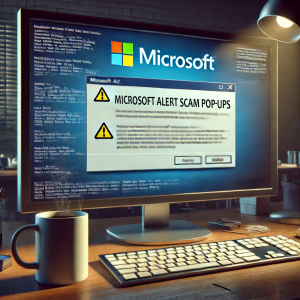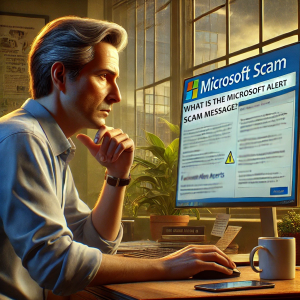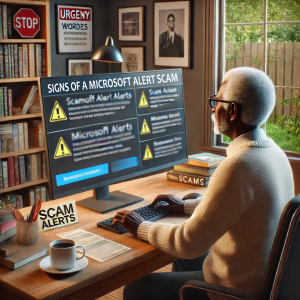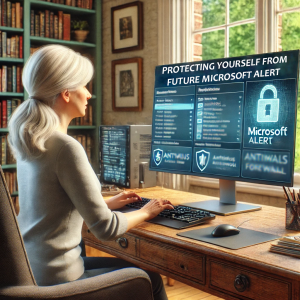Microsoft Alert Scam Pop-ups
Welcome to our comprehensive blog on the Microsoft Alert Scam, a pressing issue that affects numerous users around the globe. When it comes to internet security, understanding the complexities of these scams is not just a precaution—it’s a necessity. This blog aims to demystify the deceptive tactics behind the Microsoft Security Alert Scam, helping you distinguish between legitimate warnings and fraudulent alerts.
The Microsoft Alert Scam typically manifests through pop-ups or emails that mimic legitimate security notifications from Microsoft. These alerts often claim that your computer is at risk, infected, or compromised in some way, urging immediate action. However, these are not just harmless notifications but calculated attempts by cybercriminals to exploit unsuspecting users. Recognizing the signs of a bogus Microsoft Security Alert can save you not only from potential data loss but also from financial fraud.
In this blog, we will look deep into what makes up a Microsoft Account Security Alert Scam, showing you the common characteristics of these fake alerts and teaching you how to respond safely and securely. From the tactics scammers use to trick you into handing over sensitive information, to protective measures you can adopt to protect your digital life, this blog covers all facets of the scam.
Stay tuned as we examine each aspect of the Microsoft Security Alert Scam, providing you with the knowledge and tools to safeguard yourself and your digital identity against these suspicious schemes.
What is the Microsoft Alert Scam message?
The Microsoft Alert Scam represents a sophisticated cyber fraud tactic where perpetrators impersonate Microsoft’s security alerts to exploit users. These scams, including the Microsoft Security Alert Scam and the Microsoft Virus Alert Scam, typically present urgent, fictitious security warnings designed to manipulate users into unsafe actions.
These fraudulent alerts are commonly encountered in several scenarios:
-
Bogus Microsoft Security Alert:
Users may see alarming pop-ups or web pages claiming that their computer has been infected and urging immediate action through deceptive links or phone numbers.
-
Microsoft Scam Alert on Computer:
This type of alert disrupts internet browsing with pop-ups suggesting severe computer risks, directing users to seek supposed immediate technical support.
-
Microsoft Virus Alert Scam:
Falsely claims to detect a virus on the user’s device, pushing them to download malicious software masquerading as a security solution.
-
Microsoft Account Security Alert Scam:
Targets user accounts with notifications about alleged unauthorized access, prompting victims to verify their identities on phishing sites.
Examples of such deceptive messages include:
-
- “Critical Microsoft Security Alert: We have detected a virus on your computer. Click here to conduct an urgent security scan.”
- “Urgent: Microsoft Account Security Alert: Unusual activity detected. Verify your account immediately to avoid suspension.”
- “Warning! Microsoft Virus Alert Scam: Your device is under threat. Download our recommended antivirus tool now.”
Increasing your awareness of these Microsoft Alert Scams involves recognizing their common elements: the use of Microsoft’s trusted name, urgent security language, and calls to immediate action. These scams leverage the Microsoft Security Alert guise to elicit quick emotional reactions—fear, urgency, panic—that cloud judgment and encourage hasty decisions like sharing personal data, initiating harmful downloads, or engaging in unnecessary payments.
By becoming familiar with the signs of a bogus Microsoft Security Alert and understanding the tactics used in the Microsoft Alert Scam, you can successfully protect yourself from falling victim to these cyber threats. Recognize the red flags, question the legitimacy of unsolicited security warnings, and safeguard your digital health against these invasive scams.
How the Microsoft Alert Scam Works
Understanding how the Microsoft Alert Scam operates is crucial to recognizing and avoiding these deceptive tactics. Typically, the scam follows a calculated process that exploits human psychology using fear, urgency, and confusion through well-crafted Microsoft Security Warning messages.
The Stages of the Microsoft Alert Scam
-
Initiation:
The scam usually starts with a sudden Microsoft Spyware Alert or Microsoft Virus Warning. These alerts can appear as pop-ups on your computer, warnings from your browser, or even emails that closely mimic official Microsoft communications. The scammers design these alerts to create a sense of immediate danger.
-
Engagement:
Once the initial contact has been made, the scam message will urge the user to take immediate action. This could be through a Warning from Microsoft about a Virus, compelling the user to click on a link, download a file, or initiate a call. The message often includes technical jargon meant to confuse and intimidate the recipient into complying without questioning the validity of the alert.
-
Exploitation:
At this stage, if the user follows the scammer’s directions, they might install malicious software, inadvertently give remote access to their computer, or enter personal information into a phishing site. Scammers might use this access to install ransomware, steal personal data, or commit financial fraud.
-
Monetization:
The ultimate goal of the Microsoft Alert Scam is often monetary gain. This could be direct, through payments for fake tech support services, or indirect, by stealing sensitive information that can be used or sold later.
Psychological Tricks Used
-
Urgency:
One of the most effective tools in the scammer’s arsenal is the creation of urgency. A typical Microsoft Security Alert Scam message will claim that immediate action is required, suggesting that any delay could result in data loss or further infections.
-
Authority:
Scammers use the trusted name of Microsoft to make their Bogus Microsoft Security Alert appear legitimate. This exploitation of trust ensures that even skeptical users might second-guess their initial doubts.
-
Fear:
By issuing a Microsoft Warning Message that suggests severe security threats, scammers play directly on the fears of victims, making them anxious about potential data or financial loss.
-
Confusion:
The use of technical language can confuse users, making it more likely for them to trust the supposed “Microsoft” instructions without seeking further verification.
By dissecting the workings of a Microsoft Alert Virus scam and understanding the psychological tactics involved, individuals can better equip themselves to spot these frauds before they cause harm. Being aware that such scams often leverage urgency, fear, and the credibility of names like Microsoft will help users pause and consider the authenticity of alarming messages they receive. Remember, genuine Microsoft security alerts will never ask users to take actions that compromise their personal security or direct them to make payments.
Recognizing the Signs of a Microsoft Alert Scam
Identifying a Microsoft Alert Scam from a legitimate alert requires attentiveness to specific cues that distinguish genuine Microsoft communications from fraudulent ones. This knowledge is crucial for safeguarding your digital environment against scams like the Microsoft Security Alert Email Scam or the Microsoft Trojan Spyware Alert Scam. Here are the key indicators to help you discern these scams:
Visual and Textual Indicators
-
Visual Cues:
Genuine Microsoft alerts are professionally designed with a consistent aesthetic. Scam alerts, such as those in a Bogus Microsoft Security Alert, often feature low-quality images, mismatched fonts, and poor layout. Compare visuals of fake pop-ups with those from legitimate Microsoft security messages available on official Microsoft resources to spot discrepancies.
-
Grammatical Errors:
Microsoft Security Alert Email scams frequently contain grammatical mistakes and awkward phrasing, which are rare in official communications. Scrutinizing the language used in the alert can often reveal it to be a scam.
-
Urgency and Threats:
Scammers employ tactics like urgent language and threats of dire consequences to provoke immediate action. Official Microsoft communications maintain a professional tone and will not claim catastrophic outcomes like immediate data loss or legal consequences to coerce you into quick decisions.
Content and Context
-
Request for Personal Information:
Any communication under the guise of a Microsoft Account Security Alert Scam asking for your personal information, such as passwords or payment details, is a definitive red flag. Microsoft will never ask for sensitive information through pop-up alerts or unsolicited emails.
-
Links and Attachments:
If the alert contains hyperlinks or urges you to download attachments, hover over links to check their destinations. Scam links might mimic legitimate addresses but often have subtle misspellings or questionable domain extensions.
-
Unsolicited Contact:
Scammers might initiate contact through a Scam Microsoft Account Security Alert claiming to detect a virus or an account issue. Microsoft does not proactively send unsolicited email alerts about personal accounts or security issues without prior user action.
Technical Discrepancies
-
Sender’s Email Address:
Examine the sender’s email address in any Microsoft Security Alert Email. A legitimate email from Microsoft will come from a verifiable Microsoft domain, such as “@microsoft.com”. Addresses from free email services or with added characters are signs of a scam.
-
Mismatched URLs and Security Certificates:
Always verify the URL and security certificates of any webpage claiming to be part of Microsoft. A genuine Microsoft site will have a secure connection (https://) and a URL that exactly matches Microsoft’s official domain.
By recognizing these signs—a mixture of visual cues, content evaluation, and technical checks—you can effectively differentiate a Microsoft Alert Scam from a legitimate warning. Always approach unsolicited security warnings with skepticism and verify through official channels before taking any action suggested by a Microsoft Spyware Alert or similar scams.
Immediate Steps to Take if You Encounter a Microsoft Alert Scam
When faced with a Microsoft Alert Scam, knowing the immediate steps to take can prevent the situation from escalating and protect your personal and financial information. Whether it’s a Microsoft Trojan Spyware Alert or a Bogus Microsoft Security Alert, swift and informed actions are crucial. Here’s what you need to do if you suspect a scam:
Do Not Engage
-
Avoid Interaction:
If a Microsoft Alert Virus warning or any other suspicious alert appears, do not click on any links, do not download any attachments, and do not follow any instructions provided in the message. These actions can prevent malware from being installed or stop you from being redirected to phishing sites.
-
Close the Browser or Message:
Safely close the browser or email client. If a pop-up won’t allow you to close it, shut down your browser through the task manager (CTRL+ALT+DEL on Windows). For email scams, simply delete the email or move it to your spam folder.
Protect Your Information
-
Do Not Provide Personal Information:
Never input your credentials or financial information. The Microsoft Security Alert Scam and the Microsoft Account Security Alert Scam often seek to steal sensitive data. Remember, genuine entities will never ask for sensitive information through insecure platforms like pop-ups or unsolicited emails.
-
Avoid Making Payments:
Scammers might insist on immediate payment to resolve a supposed security issue flagged by a Microsoft Alert Scam. Remember, no legitimate company will ask for payment using gift cards, cryptocurrency, or through unsecured payment gateways under the threat of dire consequences.
Report the Scam
-
Inform Microsoft:
Reporting the incident to Microsoft can aid their efforts to combat these scams. Use their official reporting channels to inform them about the Bogus Microsoft Security Alert or any scam using their name.
-
Educate Others:
Share your experience with friends and family. Awareness is one of the best defenses against scams. Informing others about the characteristics of a Microsoft Security Alert Scam can prepare them to better handle such situations should they arise.
By following these steps, you can successfully decrease the risks associated with a Microsoft Alert Scam. Always exercise caution and prioritize your digital safety to stay one step ahead of cybercriminals.
Protecting Yourself from Future Microsoft Alert Scams
Guarding against future threats such as the Microsoft Security Alert Scam or Microsoft Virus Alert Scam requires proactive and persistent efforts in cybersecurity. By enhancing your computer and network security, adopting safe browsing habits, and continually educating yourself on the latest threats, you can greatly reduce your vulnerability to scams. Here’s how to fortify your defenses against the Microsoft Alert Scam and similar cyber threats:
Enhance Computer and Network Security
-
Regular Updates:
Keeping your operating system, browsers, and all software up-to-date is crucial. Updates frequently include security patches that protect against new vulnerabilities exploited in Microsoft Spyware Alerts and other scams.
-
Use Antivirus Software:
A robust antivirus program can detect and remove malicious software associated with Microsoft Security Warnings and Microsoft Virus Warning. Ensure it’s set to update automatically and run regular scans.
-
Enable Firewall:
A firewall helps block unauthorized access to your computer, which can prevent scammers from exploiting a Bogus Microsoft Security Alert to gain entry into your system.
-
Secure Your Network:
Use robust, unique passwords for your Wi-Fi network and all devices linked to it. Consider using a VPN, especially when connected to public Wi-Fi networks, to protect your internet connection and shield your activities from prying eyes.
Best Practices for Safe Browsing
-
Recognize Secure Sites:
When shopping or entering sensitive information online, ensure the site’s URL begins with “https,” indicating a secure connection. The presence of a padlock icon in the URL bar confirms that the website protects your data using encryption.
-
Be Skeptical of Downloads:
Only download software from reputable sites. Be cautious of websites that urge you to download software to view content, especially if they trigger a Microsoft Security Alert Scam warning.
-
Use Enhanced Security Tools:
Consider using web browser extensions that alert you to known phishing sites or malicious websites. These resources can give an extra layer of protection against the Microsoft Alert Scam.
Continuous Education on Cybersecurity
-
Stay Informed:
Frequently read up on the latest cybersecurity trends and threats. Knowing about recent scam tactics like the Microsoft Account Security Alert Scam can prepare you to recognize and avoid them.
-
Educational Resources:
Make use of the resources provided by reputable institutions in your nation, such as the Cybersecurity and Infrastructure Security Agency (CISA).
- They provide valuable insights and tips on protecting against Microsoft Security Alert Scams and more.
-
Awareness Training:
Participate in cybersecurity training sessions if available. Many workplaces offer these resources to help employees recognize and respond to threats like Microsoft Warning Messages.
By adopting these strategies, you’ll not only safeguard your personal and financial information but also contribute to a safer digital environment for everyone. As cyber threats evolve, so should your tactics in combating them, ensuring you remain a hard target for any Microsoft Alert Virus or scam attempt.
FAQs
Q1. What is a Microsoft Alert Scam?
- A. Microsoft Alert Scam involves fake warnings and alerts designed to mimic legitimate Microsoft security notifications. These scams attempt to trick users into taking harmful actions like providing personal information or downloading malware.
Q2. How can I differentiate a legitimate Microsoft Security Alert from a bogus one?
- A. Legitimate alerts will not contain grammatical errors, request personal information, or instill panic. A bogus Microsoft security alert may press you to act urgently, often accompanied by threats of data loss or account suspension.
Q3. What should I do if I receive a Microsoft Security Alert Email Scam?
- A. Do not click any links or attachments. Verify the alert by contacting Microsoft directly through official channels. Remember, a Microsoft security alert email scam often pressures you to make hasty decisions.
Q4. Are there common signs of a Microsoft Account Security Alert Scam?
- A. Yes, signs include unexpected emails claiming your account is compromised, urging you to verify your account immediately, often found in a Microsoft account security alert email scam.
Q5. What steps should I take if I encounter a Microsoft Virus Alert Scam?
- A. Close the alert or email, run an antivirus scan using reputable software, and do not interact with the alert by clicking on any links or calling back any provided numbers.
Q6. Can a Microsoft Trojan Spyware Alert be a scam?
- A. Yes, a Microsoft Trojan Spyware Alert can be fabricated by scammers to alarm you into downloading malicious software that they falsely claim is necessary for removing the supposed trojan.
Q7. What immediate actions are recommended when facing a Microsoft Scam Alert on Computer?
- A. Immediately close your browser or software application. Perform a full system scan using genuine antivirus software and report the incident to Microsoft’s fraud support team.
Q8. How can I verify a Microsoft Security Warning?
- A. Check the authenticity by logging into your Microsoft account through a safe, known path rather than clicking on any links. Official Microsoft security warnings will not ask you to provide sensitive personal details directly through pop-up windows or emails.
Q9. What are effective preventative measures against a Microsoft Spyware Alert?
- A. Regularly update your software, use strong antivirus programs, enable your firewall, and educate yourself about the latest cybersecurity threats to recognize a Microsoft spyware alert.
Q10. Where should I report a Microsoft Virus Warning if I suspect it’s a scam?
- A. Report suspected scams to Microsoft directly via their official website.
Conclusion
In this blog, we’ve thoroughly dissected the deceptive strategies behind the Microsoft Alert Scam, including the Microsoft Security Alert Scam, Microsoft Virus Alert Scam, and the Bogus Microsoft Security Alert. We’ve equipped you with the essential skills to identify such scams, emphasized the best reactions when encountering them, and provided strategies for robust prevention. Key takeaways include the importance of recognizing telltale signs of fraud such as poor grammar and urgent requests for action or information, which are common in Microsoft Security Warnings and Microsoft Scam Alerts on Computer. Additionally, it’s crucial to respond correctly by avoiding interaction with suspicious alerts, never divulging personal information, and maintaining strong digital hygiene through regular updates and safe browsing practices. As cyber threats evolve, staying vigilant and continually educating yourself and others is vital. By applying this knowledge and fostering a culture of cybersecurity awareness, you can significantly mitigate the risk of falling victim to a Microsoft Account Security Alert Scam and contribute to a safer online community for all. If you are not able to decide whether an alert message you are getting is either a scam or genuine, feel free to contact our support number mentioned on our Homepage that supports other brands as well.

